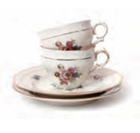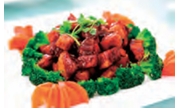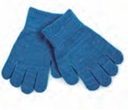- 1 分角色朗读课文 Role-play the dialogues.
- 2 根据实际情况回答问题 Answer the questions according to the actual situations.
- 你想吃什么?Nǐ xiǎng chī shénme?
- 你想喝什么?Nǐ xiǎng hē shénme?
- 明天下午你想做什么?Míngtiān xiàwǔ nǐ xiǎng zuò shénme?
- 你去哪个商店买杯子?Nǐ qù nǎge shāngdiàn mǎi bēizi?
- 一个杯子多少钱?Yí gè bēizi duōshao qián?
3 用本课新学的语言点和词语描述图片
Describe the pictures using the newly-learned language points and words.

Míngtiān wǒ xiǎng qù mǎi 明天____ 我 想 去 买 ____。

Jīntiān wǒ xiǎng chī 今天 我 想 吃_____ 。

Xiàwǔ wǒ xiǎng qù kàn 下午 我 想 去 _____看 _____。

Nǐ hǎo ,qǐngwèn zhège bēizi ? 你好 , 请问 这个杯子______ ?
汉字 Characters
1 认识独体字 Single-Component Characters
(1)“少”,意思是规模小,数量不多,与“多”相对。
In contrast to “多(many)”, “少”means “few/little”, indicating a small scale or quantity.

(2)“个”,本义是最小独立单位的人,指一个人。现在变为量词。
“个” originally meant “one individual person”. Now it has become a measure word.

2 汉字结构(3):上下结构与上中下结构
Structure of Chinese Characters (3): top-bottom and top-middle-bottom
合体结构还包括上下结构和上中下结构。上下结构的结构图形为𠃊,上中下结构的图形为𠃍。
Both the top-bottom structure and the top-middle-bottom structure are compound structures. The top-bottom structure is 𠃊 and the top-middle-bottom structure is 𠃍.
| 结构 Structure | 例字 Example Characters | 图解 Illustrations |
|---|---|---|
| 上下结构 top-bottom |
是 shì to be 爸 bà father |
是 爸 |
| 上中下结构 top-middle-bottom |
茶 chá tea 高 gāo high,tall |
茶 高 |
3 汉字偏旁“钅”和“口” Chinese Radicals: “钅” and “口”
| 偏旁 Radical |
解释 Explanation |
例字 Example Characters |
|---|---|---|
| 钅 | 金字旁,一般和金属有关系。 The radical “钅” is usually related to metal. |
钟 zhōng clock 钱 qián money |
| 口 | 口字旁,一般和嘴巴有关系。 The radical “口” is usually related to the mouth. |
吃 chī to eat 喝 hē to drink |
运用 Application
1 双人活动 Pair Work
两人一组,根据实际情况进行问答练习。
Work in pairs and ask and answer questions according to the actual situations.
例如:(1) A: Jīntiān xiàwǔ nǐ xiǎng zuò shénme?
例如:(1) A: 今天 下午你 想 做 什么?
B: ……
Míngtiān nǐ xiǎng zuò shénme?
A: 明天 你 想 做 什么?
B: ……
(2) A: Nǐmen bān yǒu duōshao ge xuéshēng?
(2) A: 你们 班 有 多少 个 学生?
B: ……
Nǐmen xuéxiào yǒu duōshao ge lǎoshī?
A: 你们 学校 有 多少 个老师?
B: ……
小组活动
Work in groups of 3 – 4. Ask about each other’s plan for the week and take notes. Each group chooses one member to make a report.
| 姓名 Name |
星期一 Monday |
星期二 Tuesday |
星期三 Wednesday |
星期四 Thursday |
星期五 Friday |
星期六 Saturday |
星期日 Sunday |
|
|---|---|---|---|---|---|---|---|---|
| 1 | 谢朋 Xie Peng |
去学校 qù xuéxiào |
去商店 qù shāngdiàn |
|||||
| 2 | ||||||||
| 3 | ||||||||
| 4 |





Comments